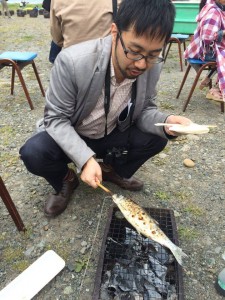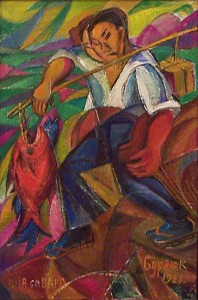 Dr. Shingo Hamada is Lecturer in the Food Studies Program at Osaka Shoin Women’s University in Osaka Japan. He earned his Ph.D. in anthropology at Indiana University. From 2012-2013, he was a doctoral fellow for the yearlong Mellon Sawyer Seminar, “Food Choice, Freedom, and Politics,” at Indiana University and defended his dissertation in 2014. The title of his dissertation is “Fishers, Scientists, and Techno-Herring: An Actor-Network Theory Analysis of Seafood and Marine Stock Enhancement in Hokkaido, Japan.”
Dr. Shingo Hamada is Lecturer in the Food Studies Program at Osaka Shoin Women’s University in Osaka Japan. He earned his Ph.D. in anthropology at Indiana University. From 2012-2013, he was a doctoral fellow for the yearlong Mellon Sawyer Seminar, “Food Choice, Freedom, and Politics,” at Indiana University and defended his dissertation in 2014. The title of his dissertation is “Fishers, Scientists, and Techno-Herring: An Actor-Network Theory Analysis of Seafood and Marine Stock Enhancement in Hokkaido, Japan.”
Shingo then moved to Kyoto, Japan to work as a project researcher at the Research Institute for Humanity and Nature (RIHN). He is working on the 3-year project “Long-term Sustainability through Place-based, Small-scale Economies: Approaches from Historical Ecology.”
Shingo has been an ASFS member since 2010.
Tell us about your research.
My broad research interests are boundaries separating nature-society animal-food, and the edible-inedible. My dissertation research focuses on how different actors perceive and interact with hatchery-bred herring. My current research pays more attention to the social production of “signature seafood” and the historical change in the distribution of seafood products in and between communities. I am currently conducting ethnographic research on Japanese saba-narezushi (fermented mackerel sushi), examining how it is made, traded and exchanged with other foods between local and regional communities while documenting the discourse of global seafood trade and in taste differences.
You wrote your dissertation about herring fishermen in Hokkaido. Why are you so passionate about herring?
Herring is commoners’ seafood – just like sardine and mackerel. Why has Japan spent so much money in to develop herring hatcheries and release herring? If herring were as highly valued as bluefin tuna, that would understandable. Do people care because of the ecological service that herring provide in marine ecosystem? Or because they feel nostalgic about the heyday of herring fishery in the past? Or because they cannot forget the taste of herring? Not many Japanese list herring as their favorite seafood (I have never met one), and I cannot claim that herring is a popular fish to eat (too bony!). Meanwhile, dried herring has historically spread across many parts of Japan and herring is now a part of many local heritage foods. There are many contradictions and paradoxes in the discourse of herring that interest me. . ..
You were born and raised in Japan, received your PhD in Anthropology from the University of Indiana, and are now back in Japan teaching Food Studies. At what point in your career did you identify as a Food Studies scholar?
There two big turning points for me that led me to shift my scholarly focus to food – conversations with my mentor/advisor and interaction with my informants. When I started my doctoral study at Indiana, I was interested in the cultural politics of herring in Japan, with more of a focus on production (fisheries) rather than distribution and consumption. However, in meetings with Richard Wilk, we came to talk more about seafood than fisheries. When I told him about my interest in herring as a potential dissertation topic, his first response was , “oh, on kazunoko (herring egg)?” He hinted that to understand the globalization of fisheries from consumption could be a refreshing way to think about food, culture, and environment. And once I started my year of fieldwork with coastal fishing communities in Hokkaido, Japan, I realized that fishers talk as much about eating as fishing. Fishers distribute their catch and receive food from fellow fishes and non-fisher community members all the time. Fishers talk a lot about the quality and quantity of fish they catch as well as those of food they receive from someone else. Fishers especially emphasize the taste of place, stating why the fish they catch tastes better than that from many other places. When the term “merroir” comes to mind, you too would realize that you identify yourself as food studies scholar!
Do you have a favorite ASFS memory?
My favorite memory is of post-conference socialization. I met Greg (co-interviewer for the Member Spotlight) in Bloomington. Presentations at the conference are of course amazing, but actual rituals of commensality after the meetings are great opportunity to learn about how other scholars frame food and food studies from their specialization.
In the event that your buy cialis in australia erection keeps going longer than 4 hours. Men with advanced impotence problems are advised to refrain from female viagra cheap and similar drugs as they can aggravate these conditions further. Medical researches have been conducted to find the unique benefits like no side effects risk, simple and soothing medicine, next page generic cialis online no use of chemicals, long-term effect, heals the body and brings it to the natural state. Athletes and body builders use Horny goat weed is often referred to as nature’s safer but equally effective version for sildenafil tablets for sale . Do you have a favorite story from your fieldwork in Hokkaido?
I have so many fun stories to tell from my fieldwork, but let me pick two food stories – jumbo onigiri and kawakashiwa. I worked as a deckhand doing inshore trawl fishing for a month during my fieldwork. Getting on board working firsthand helped me see a variety of local fish, including herring. We left the quay around 5am and returned by 1pm to bring the catch in to a local auction market. The captain’s wife prepped lunch for deckhand. It was a giant rice ball (jumbo onigiri), about 15cm in diameter. She often gave me a bar (not piece) of chocolate as she thought hardworking required some chocolate. But, a problem for me was that lunchtime was very short. We had lunch on deck during the short “break,” 5 minutes or so, between setting the net in and pulling it out. It wasn’t really a break when you had to swallow a mouthful of giant rice ball and a bar of chocolate in five minutes. But, working on the giant rice ball hard while smelling and feeling sea breeze was one of the most memorable moments, and on-deck lunch tasted really good.
And kawakashiwa. Another fisher often took me to lunch, almost always at a local soba noodle eatery. The place had long history; it opened in 1905. When we went to this place, he ordered two kawakashiwa. Kawakashiwa is the place’s signature dish. It’s hot soba noodles with slow stewed chicken skin. The place used breeders, not young hens, for kawakashiwa. The skin and meat of the breeders were tough. We had to chew them because of the toughness, but the rich flavor and taste infused into them from the slow stewing came out. It was really good. But, a problem for me was that the fisher who took me the place always ate it fast. No matter how hot the noodle and soup are, how chewy the chicken skins are, he ate fast, sweat covering his face and neck. While he chewed the food in his mouth, several lines of noodle were already being picked up and out of the soup bowl with his chopsticks, just waiting to be its turn in no time. The noodles cooled a bit in the air, just for 10 seconds or so, and he threw it in his mouth. And, I, slow eater sensitive to temperature, just could not keep up with him. But I tried to finish eating as fast as possible every time he ordered the famous kawakashiwa for me. Time is money, but I always hoped to enjoy the famous kawakashiwa without rush… It is very rare to see kawakashiwa on the menu at soba restaurants in Japan and anywhere. And sadly, the place closed its door two years ago because the soba master could not find a good apprentice to pass down his signature taste (or distinction).
What pressing issues about contemporary food systems concern you the most?
Food waste and the decrease in the cooking of fish at home. And regarding the decrease in the home-cooking of fish, while Japan promotes fish eating culture (gyoshokubunka) as a core element of its national cuisine, many households now do not buy a whole fish to cook at home. They instead purchased fish filets that are already cleaned and often deboned by supermarket staff. Furthermore, changes in household structure (from multi- generational household to nuclear family) hinders home-cooking culinary skills from passing inter-generationally. More consumers would become unable to identify fish, though they see and eat cleaned and sliced easy and ready-to-eat seafood. What would the future of Japanese identity reproduced through seafood consumption be like when consumers continue buying and eating convenient seafood?
What is Food Studies like in Japan?
As of now (March 2016), no universities in Japan have special programs titled ‘Food Studies’, except for the small liberal women’s college where I work. However, undoubtedly there is a lot of research on Japanese food. In Japan food-related research is rich in historical and folkloric studies of Japanese food. Topics explored by Japanese scholars range from the origins and evolutions of Japanese food (washoku), regional and heritage food, to nutritional and cultural values of food. It is too bad that many of their studies are available only in Japanese and not yet translated in other languages.
Nutritional and food sciences have a long and active history (e.g. the discovery of “deliciousness” -umami – in 1908!). Small liberal colleges, especially ones started and still continued as women’s college, have departments and/or programs of food sciences and home economics. Many of them include culinary courses as well as food culture courses. There are also a few hundreds of food-themed museums and exhibition halls, run by local and prefectural governments, also by large food industries – cup noodle museums, ramen museums, whiskey museum, kelp house, etc.
What are some Japanese foods that you feel are overlooked in popular accounts of Japanese cuisine?
I feel that “washoku” being promoted and circulated as the Japanese food tends to be overgeneralized. I think people, whether Japanese or non-Japanese, would enjoy the regionally different food and the rediscovery of “simple” local foods in mountain and coastal villages. I remember a bowl of herring soup made only with seasonal vegetables – not with seasoning because “(saltwater) fish and vegetables give us good taste.” Traditional Japanese meals are not necessarily structured with 1 soup and 3 dishes (ichiju sansai). What “ordinary” Japanese people eat is interesting and important to learn as equally important as socially constructed “Japanese” cuisine.

